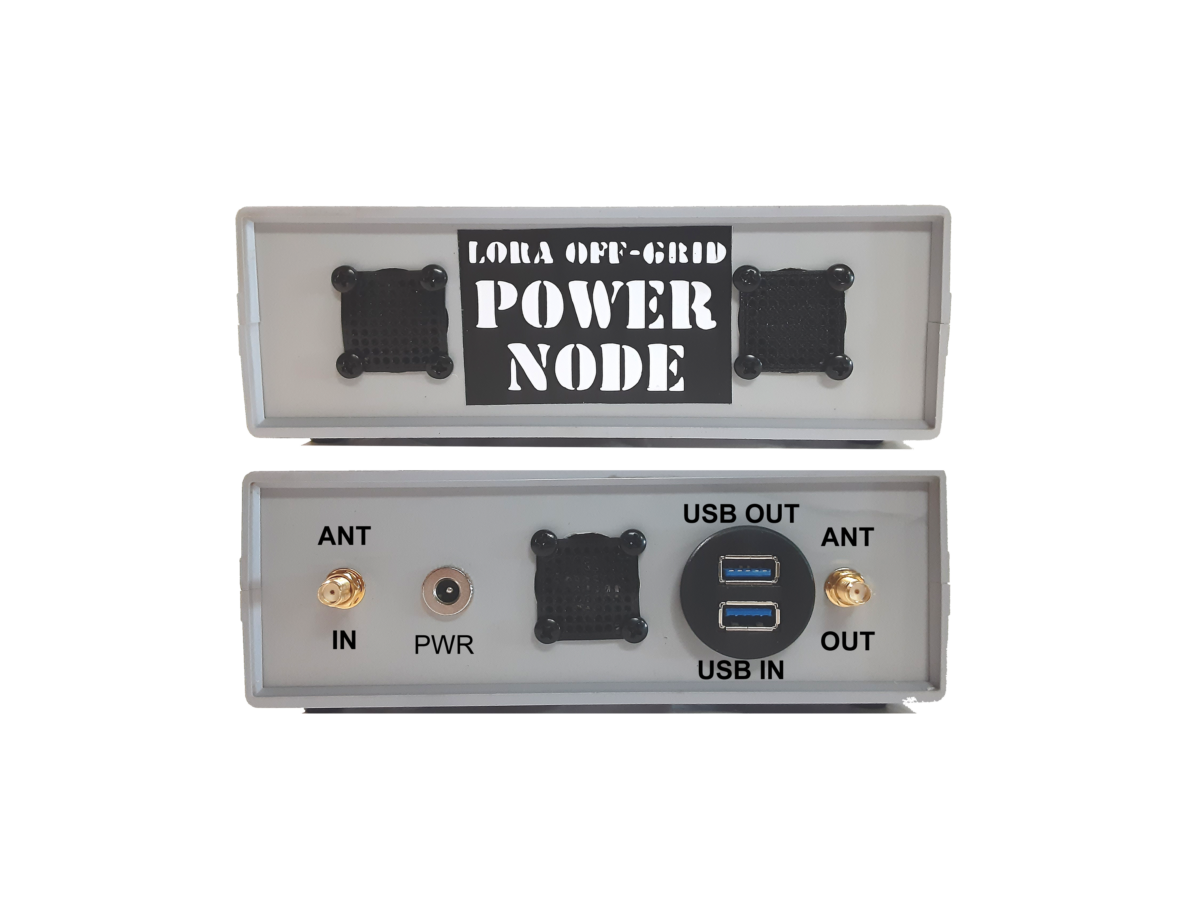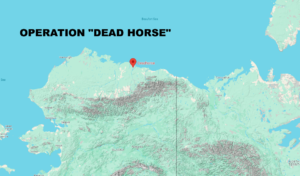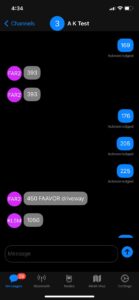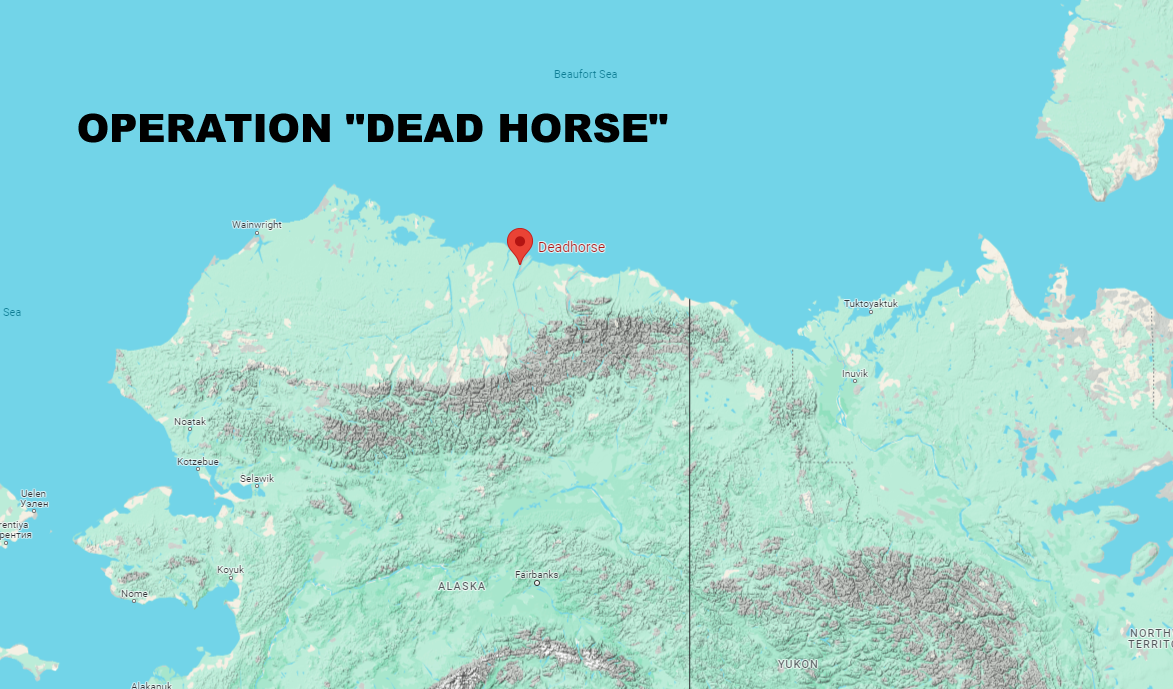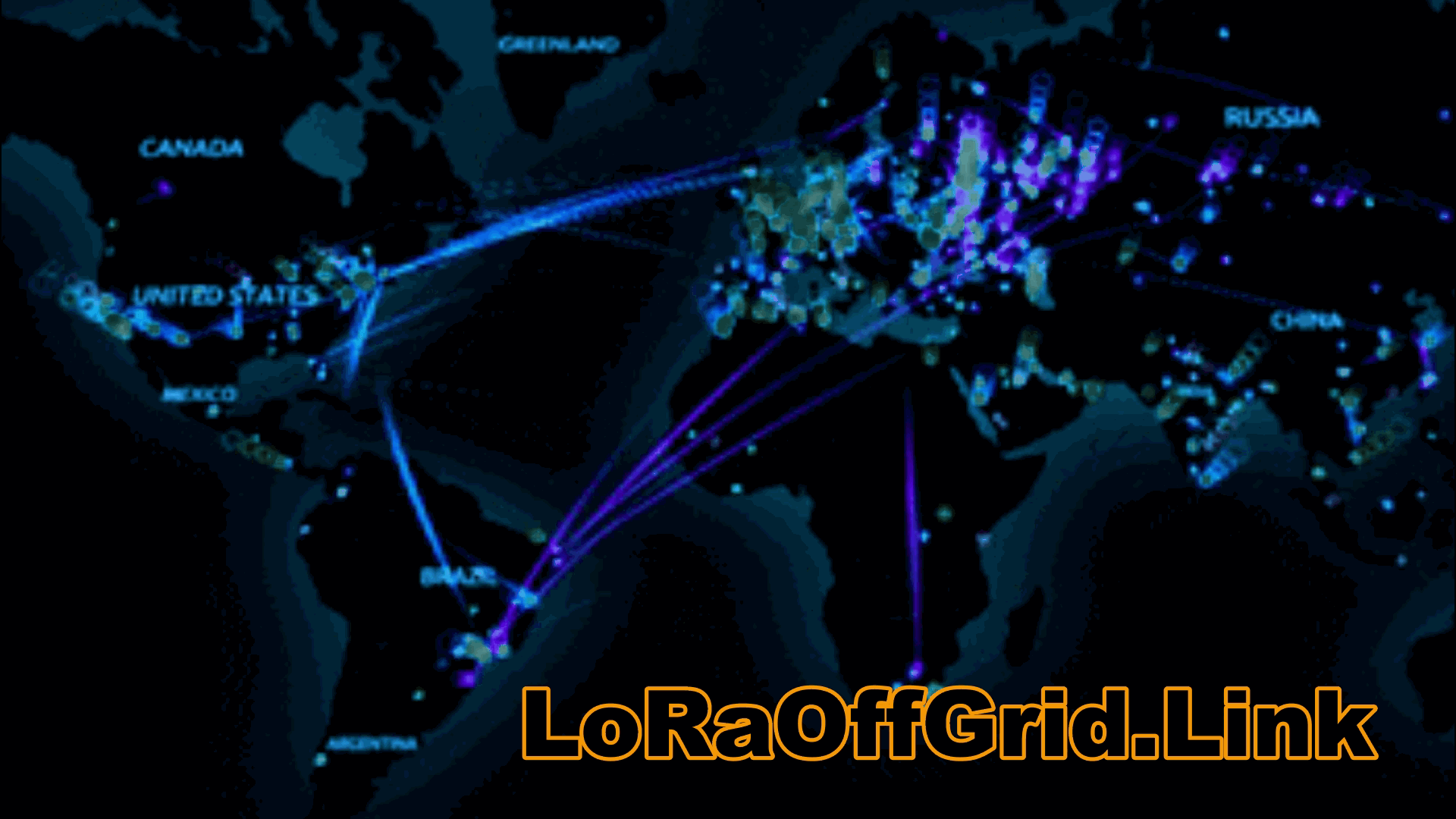Category: Uncategorized
The Larping Discord Minecrafters On MQTT – What’s The Deal?
As the owner of one of the first ten nodes on the mesh I can say that I have been around since the beginning. I have noticed quite a few changes since then. From emoji names to the kiddie discords, LongFast MQTT has gone from a reasonable place to hang out to romper room almost overnight. I’m not a babysitter and now I don’t even go into LongFast until after 9pm when the children have all gone to bed.
 I tell myself not to sweat it as the more nodes on the mesh the better, but, as we know, the PTB have been full on slamming LoRa/Meshtastic as a place where the Mexican drug cartels and Hamas terrorists like to do their business because it’s the last place on earth that private messaging can be encrypted and now, it’s even listed on the FBI and Homeland Security websites.
I tell myself not to sweat it as the more nodes on the mesh the better, but, as we know, the PTB have been full on slamming LoRa/Meshtastic as a place where the Mexican drug cartels and Hamas terrorists like to do their business because it’s the last place on earth that private messaging can be encrypted and now, it’s even listed on the FBI and Homeland Security websites.
And then it dawned on me, of course the feds have infiltrated it and are just stinking the place up trying to either make people go away or trying to setup these kiddie minecrafters in some crazy psyop through their discord servers or otherwise just as hey have done a million times across thousands of platforms. So, it is what it is. The kiddies have no idea they might be getting setup to be used as an eventual take down going the tiktok route.
FEDs generally use the lowest IQ denominators for solicitation and their tactics don’t change from place to place on the internet. They are famous for using childish emojis and picture names and have become synonymous with undercover live action role playing and child predation, so anytime I see it, I know what I am probably dealing with.
My advice to new meshers is, be aware that operations could be occurring and you might want to stay off LongFast for the foreseeable future. Make a private channel for you and your friends and if you want some good mesh advice, find a HAM!
Testing “Project PowerNode” – the 915MHz LoRa Amplifier / Booster
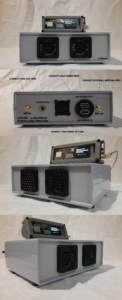 Upon hearing of the new build from a well known HAM and finally getting our hands on the final production LoRa Off-Grid PowerNode we wanted to run it though some range trials. But first, we needed to have a baseline to work from using the same setup without the Power Node using two T-Beam Supremes.
Upon hearing of the new build from a well known HAM and finally getting our hands on the final production LoRa Off-Grid PowerNode we wanted to run it though some range trials. But first, we needed to have a baseline to work from using the same setup without the Power Node using two T-Beam Supremes.
One stationary unit on a mast 30ft off the ground and one unit placed in the vehicle with an external antenna mounted to top of vehicle. After doing some range tests our results were as expected with the horrible terrain on a dreary rainy Sunday. Our average distance was between 3.8 and 4.2 miles. Not bad in consideration of the terrain we were working with which I honestly didn’t think we would get a mile knowing what I do about LoRa devices and the 915MHz band we were working in.
As you can see from the map, our footprint was tiny using stock equipment.
Testing, Parameters and Equipment:
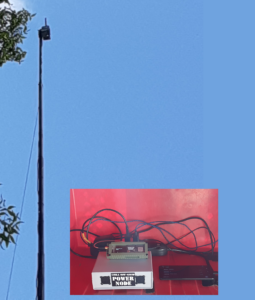 With our baseline testing down now it was time to get to the meat of this testing of the LoRa Off-Grid PowerNode. No changes to the equipment were made except to insert the PowerNode at the stationary T-Beam. Again, this T-Beam antenna was installed on a 30ft mast as stated in the baseline test.
With our baseline testing down now it was time to get to the meat of this testing of the LoRa Off-Grid PowerNode. No changes to the equipment were made except to insert the PowerNode at the stationary T-Beam. Again, this T-Beam antenna was installed on a 30ft mast as stated in the baseline test.
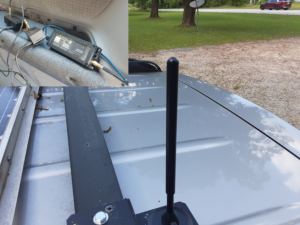 The antenna’s on the mast and on the exterior of vehicle were Bingfu Lora Antennas 915mhz 3dbi Omnidirectional from Amazon [https://www.amazon.com/dp/B09XMH2MM6 ]
The antenna’s on the mast and on the exterior of vehicle were Bingfu Lora Antennas 915mhz 3dbi Omnidirectional from Amazon [https://www.amazon.com/dp/B09XMH2MM6 ]
Environmental & Terrain Parameters:
Environmental conditions were; 70 degrees F, Cloudy, Rain and the terrain was very rural, mostly old growth forestry with a smattering of farms, residential subdivisions and sparse industrial.
So the conditions and terrain were about as bad as one could find when attempting to test a UHF RF product as old growth forestry is a ground propagation RF killer. Elevation differences were between 360ft ASL – 420ft ASL +- 20ft with the stationary node being at 384ft ASL.
Testing and Results:
Driving out in all available directions one could drive, our range testing gave us a nominal 40+ mile distance between the two nodes with a few 50+ mile acks. The only time we didn’t get acks was when we were in very, very low dips in the terrain or blocked by extremely large industrial farm buildings that consumed the horizon. 97% of all TX RX was acknowledged on both ends.
Summarized Conclusions:
After the testing concluded and the CSV files were tallied up we all sat in utter disbelief. We were literally stunned beyond any and  all explanation. We had known before-hand the specifications listed for this LoRa amplifier / booster but it wasn’t until we looked at the phenomenal distances driven and comparing the coverage maps between the baseline and final that the realization sank in. Going from a tiny speck of coverage on the map to the undeniable multi county coverage splash was absolutely astounding to the 4 very qualified radio guys in the little HAM shack on the side of the highway. We all knew that the design builder of the device was well known for his custom repeater and amplifier builds in the HAM community, it seems that everyone has either touched or heard of one of his builds. A very un-assuming and down to earth gentleman with a rich and seemingly innate understanding of RF electronics that most cannot even begin to grasp. I knew right there and then that he had single handedly changed the LoRa game entirely and his callsign is K4ZXX.
all explanation. We had known before-hand the specifications listed for this LoRa amplifier / booster but it wasn’t until we looked at the phenomenal distances driven and comparing the coverage maps between the baseline and final that the realization sank in. Going from a tiny speck of coverage on the map to the undeniable multi county coverage splash was absolutely astounding to the 4 very qualified radio guys in the little HAM shack on the side of the highway. We all knew that the design builder of the device was well known for his custom repeater and amplifier builds in the HAM community, it seems that everyone has either touched or heard of one of his builds. A very un-assuming and down to earth gentleman with a rich and seemingly innate understanding of RF electronics that most cannot even begin to grasp. I knew right there and then that he had single handedly changed the LoRa game entirely and his callsign is K4ZXX.
Operation “Dead Horse II”
Operation Deadhorse – Part 2
 osition numbers corresponding to locations on our map and determine how many and, what communications were received from each radio.
osition numbers corresponding to locations on our map and determine how many and, what communications were received from each radio.
Operation “Dead Horse”
Tale of the T-Beams
LoRa Range Test in the Open Tundra
KK7HMX / KL5MU
Deadhorse is an unincorporated community located within the CDP of Prudhoe Bay in North Slope Borough, Alaska, United States, along the North Slope near the Arctic Ocean. The town consists mainly of facilities for the workers and companies that operate at the nearby Prudhoe Bay Oil Field.
With all the questions about the range of various LoRa devices we have tried to get some tangible and semi-scientific results in an ideal baseline terrain. After day one of doing some preliminary testing with some satisfactory results we devised a way to test both the range and repeater function of three identical Lilygo T-Beam devices.
Testing Methods and Parameters and Equipment:
Three Lilygo T-Beam with Stock antennas
These nodes were all protected in 3D printed cases
The nodes were wrapped in paper bags then, plastic protective bags to help protect them from snow and condensation.
Two of the nodes were then taped to wooden stakes and vertically mounted in a truck bed at approximately 11′ above ground level.
The 3rd node was also mounted to a slightly shorter wooden stake and used as a repeater to communicate between the 1st and the 2nd node.
Cell Phone signal and wi-fi was turned off on each phone connected to a LoRa device to prevent MQTT transmit.
Two Android cell phones and one IPhone were then only connected via blue-tooth and the Meshtastic App.
Communications were tested at each mile clocked on the reset odometer with a return confirmation that the mile mark was received.
Environmental Parameters: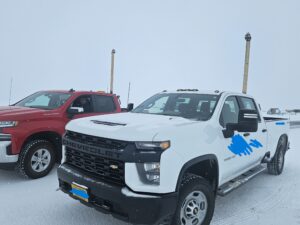
The location of these tests were conducted on the Dalton Highway in North Alaska at an approximate latitude of 70N.
This is a very flat and tree-less terrain with some slight variation in topography and elevation and nearly a straight road to obtain test distance.
Current test temperature of 18F with moderate visibility out to about 3/4 mile and, with light blowing snow. Easterly wind at approximately 8mph.
The Kp index in the time frame of this test was about 3Kp around 12pm.
Testing and Results: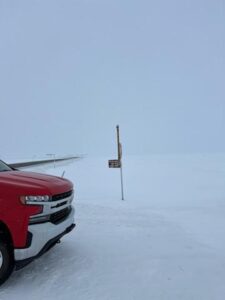
On the first day of this test we had a max range of about 9 miles. We simply had the nodes placed on the dash of the waiting truck facing the driving truck and, in the case of the driving vehicle facing out the rear window behind the rear seat. We obtained a max range of 9 miles and communications were spotty at this distance. There were many issues with this first test in the way it was conducted but, it was a good baseline to get an idea of how far our units could reliably send/receive signals. We were not testing repeater function. We only tested a point to point distance test on this day.
On our second day of tests we decided to conduct two tests at once. The first test would be a point to point node test with an increase and, standardization in antenna mounting height. The second test would be to drop a node between the two primary communicating T-Beams to verify that it would preform repeater function and continue our distance test with a repeater node placed. The repeater node was placed as close as possible to the max distance we achieved point to point.
For this test we mounted the two primary nodes at 11 feet above ground level (road surface) to a wooden stake strapped in a vertical position above the roof of the truck.
The node intended as a repeater was also placed on a wooden stake and this would be mounted to a road sign or mile marker. The node was placed in the back of the driving truck for deployment at the edge of the radio’s range and the cell phone it was connected to remained in the stationary truck just to help verify none of these communications were coming through the cell phone network and to leave the node to function independently as designed.
would be mounted to a road sign or mile marker. The node was placed in the back of the driving truck for deployment at the edge of the radio’s range and the cell phone it was connected to remained in the stationary truck just to help verify none of these communications were coming through the cell phone network and to leave the node to function independently as designed.
On our second range test the driving vehicle go to about 13 to 14 miles away from the parked truck. Communications were spotty and unreliable at this distance. Both of us got failed messages. The driving truck then returned to 11.7 miles where reliable coms between our two units was again established and, the repeater node was strapped to a sign at approximately 9 feet above the road surface.
The Driving truck continued on away from the parked truck and placed repeater node left at the 11.7 mark. Communications worked flawlessly until he got about 9.3 miles away from the repeater where, communications were spotty and then dropped off completely past that distance. So, The driving truck was 9.3 miles away from the repeater and 21 miles away from the stationary truck.
Summarized Conclusions:
On open, flat and tree-less ground these Lilygo T-Beam radios with stock antennas are capable of transmitting close to 10 miles as reliable max range estimate with MQTT disabled. We proved this to ourselves with a quick test out to 9mi and, a test with elevated radios at 11 feet having reliable point to point communications at 11.7 miles.
A node placed as a simple repeater device effectively preformed its task with no apparent communications issues passing communications between the other two test nodes.
No Looped messages were received by either node and, we believe looped messages are a function of the MQTT server or some other problem but, this issue does not show up when using the radios w/o MQTT.
We plan on conducting more tests to verify if weather affects range and, what better upgraded antennas will do to increase the range for these radios.
Ideas for other tests and feedback is appreciated.
KK7HMX
